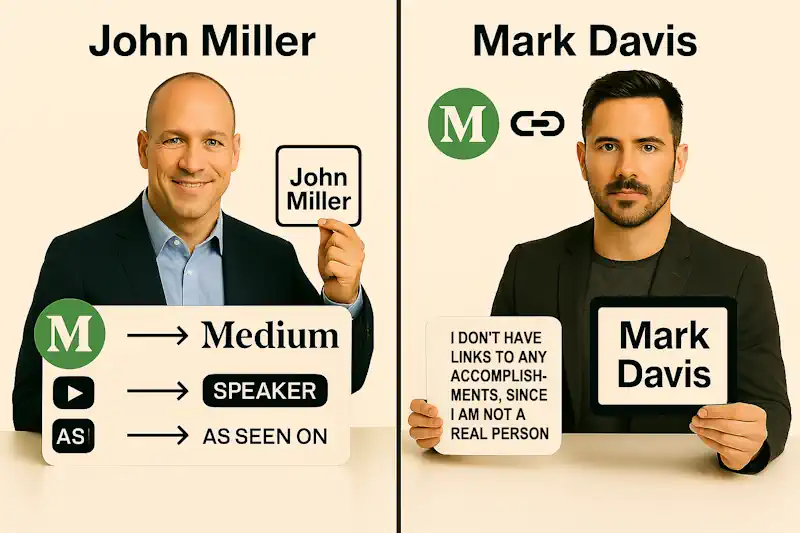Creating a Strategic Identity
Before you create your Medium account, it’s worth taking a step back and thinking about how you want to present yourself. Not just how your profile looks or which topics you’ll write about, but the name behind the content.

On Medium, you can write under your real name, a pen name, or even create multiple identities for different topics. There’s no right or wrong answer, but the choice affects how people perceive you, how you build trust, and how you connect your content to other parts of your business.
Making this decision upfront saves time and avoids messy rebranding later. It also shapes how you think about your account structure, especially if you plan to write in more than one niche.
The Power and Practicality of Pen Names
Writing under a pen name is more common than you might think. Authors, columnists, and creators have used them for decades—sometimes to separate personal and professional lives, other times to protect privacy, or just to create a brand with more personality.
On Medium, you’re free to do the same. You can create a name that matches the tone of your writing or fits the niche you’re working in. For example, someone writing about digital marketing for beginners might choose a casual name that sounds approachable.
Someone writing about high-level business strategy might go with a more formal or professional-sounding name. It’s all about what fits the identity you want to project.
Advantages of Pen Name Publishing
There are clear advantages to using a pen name:
- Privacy Protection: It gives you a layer of separation from your personal life, which can be helpful if you’re exploring controversial topics, starting out in a new field, or simply don’t want your friends and family Googling your latest article.
- Brand Consistency: A pen name makes it easier to stay on brand. You can tailor your tone, style, and visual identity to fit that persona without worrying about whether it aligns with the rest of your online presence.
- Niche Exploration: If your real name is already tied to another business or niche, a pen name lets you explore something different without confusing your existing audience.
When Real Names Work Better
That said, using a pen name isn’t always ideal:
- Trust Transfer Challenges: It can make it harder to transfer trust from one platform to another. If someone follows you on Medium and wants to check out your website, they might not realize it’s connected unless your branding makes that connection obvious.
- Credential Limitations: It also limits the power of real-world credibility. If you’ve been featured in big-name outlets or spoken at events, those accomplishments carry more weight when tied to your real name.
- Brand Management Overhead: You’ll need to keep track of how each identity is presented, which can turn into extra work if you’re juggling multiple personas across different channels.

Multiple Niches, Multiple Names?
If you’re thinking about writing in several niches, it’s worth considering separate pen names for each one. Readers on Medium tend to follow people for specific content. If someone subscribes to you for your email marketing tips, they probably don’t want to see your thoughts on mindfulness or parenting in their feed.
Separate names allow you to tailor everything—from voice and tone to visuals and calls to action—without diluting your message. You don’t have to make a full-blown business out of each one.
Sometimes, a simple alias is enough. However, separating your content this way helps you avoid confusing your audience and keeps your branding sharp.
Managing Multiple Medium Accounts
Managing multiple accounts is allowed on Medium, but you’ll want to be strategic about it. Each account needs its own email address, and you’ll have to log in and out if you’re switching between them on the same device. This can get tedious, especially if you’re publishing often.
Some creators solve this by dedicating one browser or device to each persona. Others use browser profiles to stay logged into separate accounts. The key is to stay organized.
Keep track of what content goes where, which pen name is attached to which niche, and how each account is performing. Medium won’t manage this for you. It’s all on you to keep the identities clean and consistent.
Choosing an Effective Pen Name
When choosing a pen name, don’t overthink it, but don’t be careless either:
- Authenticity First: Pick something that sounds like a real person unless you’re going for a clearly fictional or brand-like identity.
- Usability Matters: Avoid names that are hard to spell, too similar to well-known public figures, or already used by other writers on Medium. You can do a quick search on the platform to check.
- Brand Alignment: If you want to connect the pen name to your business, consider using a name that includes a relevant keyword or ties into your domain name. For example, if your brand is about side hustle strategies, a name like “Shawn Sidewell” might blend professionalism with brand relevance. Subtle cues like this make it easier for readers to remember you and associate you with your topic.
Creating a Cohesive Cross-Platform Identity
Once you’ve picked a name, think about how that identity will carry across platforms. If you’re planning to use Medium to drive traffic to a website, email list, or social account, those links need to match the name people are seeing.
If your pen name is James Riley and your site is SuccessWithSharon.com, you’ve got a disconnect. It doesn’t mean you can’t link them, but you’ll have to work harder to explain the connection.

Ideally, your pen name, domain, and social handles should form a clean triangle—recognizable, cohesive, and easy to follow across touchpoints.
Profile Photos and Visual Identity
Even something as simple as your photo can make a big difference. If you’re using a pen name, don’t use a stock image or a cartoon avatar unless that fits your niche. Try using a real photo, even if it’s not of you, as long as it feels authentic to the persona.
Some people use AI-generated faces for anonymity while still giving a human impression. Others take their own photo and apply filters or tweaks to maintain some privacy.
Whatever you choose, the goal is to build enough trust that people believe a real person is behind the content, even if they don’t know exactly who.
Using Your Real Name Effectively
If you’re using your real name, then everything needs to tie together with more precision:
- Visual Consistency: Your photo should match your other platforms.
- Voice Alignment: Your bio should sound like you, not like someone else writing in your place.
- Tone Continuity: Your voice and tone should be consistent with how you show up on LinkedIn, X, or your personal blog.
If someone clicks from your Medium profile to your website, they shouldn’t feel like they’re entering a different world. That kind of consistency builds familiarity, and familiarity builds trust.
Building a Publishing Brand Without Complexity
Branding on Medium doesn’t require logos, taglines, or fancy design. But it does require thought. You’re creating a publishing identity, and people will make judgments based on what they see.

Whether you go with your real name or a pen name, what matters most is staying consistent and intentional. Readers follow personalities as much as they follow topics. They want to feel like they know the person behind the writing. Give them a reason to stick around. Make your name—whichever one you choose—worth remembering.
This was part 3 of our Medium series. Next in our series: Setting Up for Success: A Marketer’s Guide to Medium Basics– Learn how to navigate Medium’s platform and set up your account for success. Or return to the intro and the full series’ Table of Contents.

